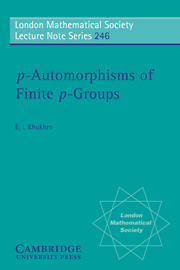Book contents
- Frontmatter
- Contents
- Preface
- Introduction
- Chapter 1 Preliminaries
- Chapter 2 Automorphisms and their fixed points
- Chapter 3 Nilpotent and soluble groups
- Chapter 4 Finite p-groups
- Chapter 5 Lie rings
- Chapter 6 Associated Lie rings
- Chapter 7 Regular automorphisms of Lie rings
- Chapter 8 Almost regular automorphism of order p: almost nilpotency of p-bounded class
- Chapter 9 The Baker–Hausdorff Formula and nilpotent ℚ-powered groups
- Chapter 10 The correspondences of A. I. Mal'cev and M. Lazard
- Chapter 11 Powerful p-groups
- Chapter 12 Almost regular automorphism of order pn: almost solubility of pn-bounded derived length
- Chapter 13 p-Automorphisms with p fixed points
- Chapter 14 Automorphism of order p with pm fixed points: almost nilpotency of m-bounded class
- Bibliography
- Index of names
- Subject Index
- List of symbols
Chapter 8 - Almost regular automorphism of order p: almost nilpotency of p-bounded class
Published online by Cambridge University Press: 22 October 2009
- Frontmatter
- Contents
- Preface
- Introduction
- Chapter 1 Preliminaries
- Chapter 2 Automorphisms and their fixed points
- Chapter 3 Nilpotent and soluble groups
- Chapter 4 Finite p-groups
- Chapter 5 Lie rings
- Chapter 6 Associated Lie rings
- Chapter 7 Regular automorphisms of Lie rings
- Chapter 8 Almost regular automorphism of order p: almost nilpotency of p-bounded class
- Chapter 9 The Baker–Hausdorff Formula and nilpotent ℚ-powered groups
- Chapter 10 The correspondences of A. I. Mal'cev and M. Lazard
- Chapter 11 Powerful p-groups
- Chapter 12 Almost regular automorphism of order pn: almost solubility of pn-bounded derived length
- Chapter 13 p-Automorphisms with p fixed points
- Chapter 14 Automorphism of order p with pm fixed points: almost nilpotency of m-bounded class
- Bibliography
- Index of names
- Subject Index
- List of symbols
Summary
Now we are in a position to prove the first of the main theorems on finite p-groups with p-automorphisms having few fixed points. If such an automorphism is “almost regular”, with pm fixed points, then the group is “almost nilpotent”: it has a subgroup of (p, m)-bounded index and of nilpotency class at most h(p), where h is Higman's function. This bound for the nilpotency class of a subgroup of (p, m)-bounded index is best possible, if required to depend on the order of the automorphism only. The result of this chapter will be used in Chapters 13 and 14.
Theorem 8.1.If a finite p-group P admits an automorphism φ of prime order p with exactly pm fixed points, then P has a characteristic subgroup of (p,m)-bounded index which is nilpotent of class at most h(p), where h(p) is the value of Higman's function.
The proof relies on Higman's Theorem from § 7.2 on regular automorphisms of Lie rings in its combinatorial form and on the use of the associated Lie rings. Note that, at a first glance, an application of Higman's Theorem to L(P) and the induced automorphism φ cannot give us much information, since not only is φ not regular, but the number of fixed points of φ on L(P) can be much greater than on P, by a factor equal to the nilpotency class, say. Anotherimportant tool in the proof is a theorem of P. Hall from § 4.2.
Information
- Type
- Chapter
- Information
- p-Automorphisms of Finite p-Groups , pp. 95 - 100Publisher: Cambridge University PressPrint publication year: 1998
